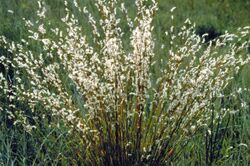Biology:Andropogoneae
| Andropogoneae | |
|---|---|

| |
| Andropogon scoparius | |
| Scientific classification | |
| Kingdom: | Plantae |
| Clade: | Tracheophytes |
| Clade: | Angiosperms |
| Clade: | Monocots |
| Clade: | Commelinids |
| Order: | Poales |
| Family: | Poaceae |
| Clade: | PACMAD clade |
| Subfamily: | Panicoideae |
| Supertribe: | Andropogonodae |
| Tribe: | Andropogoneae Dumort. (1824) |
| Subtribes | |
|
12 subtribes, see text | |
| Synonyms[1] | |
| |
The Andropogoneae, sometimes called the sorghum tribe, are a large tribe of grasses (family Poaceae) with roughly 1,200 species in 90 genera, mainly distributed in tropical and subtropical areas. They include such important crops as maize (corn), sugarcane, and sorghum.[2] All species in this tribe use C4 carbon fixation, which makes them competitive under warm, high-light conditions.[3]
Andropogoneae is classified in supertribe Andropogonodae together with its sister group Arundinelleae. Subdivisions include 12 subtribes, but the position of several genera within them is still unresolved (incertae sedis). Hybridisation was probably important in the evolution of the Andropogoneae, and the tribe's systematics is still not completely resolved.[3]
Description
Spikelets within the inflorescence (flower cluster) are generally arranged on spicate racemes in pairs. A fertile, unstalked spikelet is subtended by a sterile, stalked spikelet. In species where awns are present they are found on the fertile, unstalked spikelet as an extension of the lemma.[4]
Subtribes and genera
Classification following Soreng et al. (2017).[1]
References
- ↑ 1.0 1.1 Soreng, Robert J.; Peterson, Paul M.; Romaschenko, Konstantin; Davidse, Gerrit; Teisher, Jordan K.; Clark, Lynn G.; Barberá, Patricia; Gillespie, Lynn J. et al. (2017). "A worldwide phylogenetic classification of the Poaceae (Gramineae) II: An update and a comparison of two 2015 classifications". Journal of Systematics and Evolution 55 (4): 259–290. doi:10.1111/jse.12262. ISSN 16744918.
- ↑ Also called "kaoliang": "Shensi", in The Columbia-Viking Encyclopedia (1953), New York: Viking. Another spelling is "gaoliang."
- ↑ 3.0 3.1 Soreng, Robert J.; Peterson, Paul M.; Romschenko, Konstantin; Davidse, Gerrit; Zuloaga, Fernando O.; Judziewicz, Emmet J.; Filgueiras, Tarciso S.; Davis, Jerrold I. et al. (2015). "A worldwide phylogenetic classification of the Poaceae (Gramineae)". Journal of Systematics and Evolution 53 (2): 117–137. doi:10.1111/jse.12150. ISSN 1674-4918.

- ↑ Skendzic, Elizabeth; Columbus, J. Travis; Rosa, Cerros-Tlatilpa (2007). "Phylogenetics of Andropogoneae (Poaceae: Panicoideae) Based on Nuclear Ribosomal Internal Transcribed Spacer and Chloroplast trnL–F Sequences". Aliso: A Journal of Systematic and Evolutionary Botany 23 (1): 530-544. doi:10.5642/aliso.20072301.40. https://scholarship.claremont.edu/aliso/vol23/iss1/40/. Retrieved 14 April 2020.

Wikidata ☰ Q3780208 entry
 |

